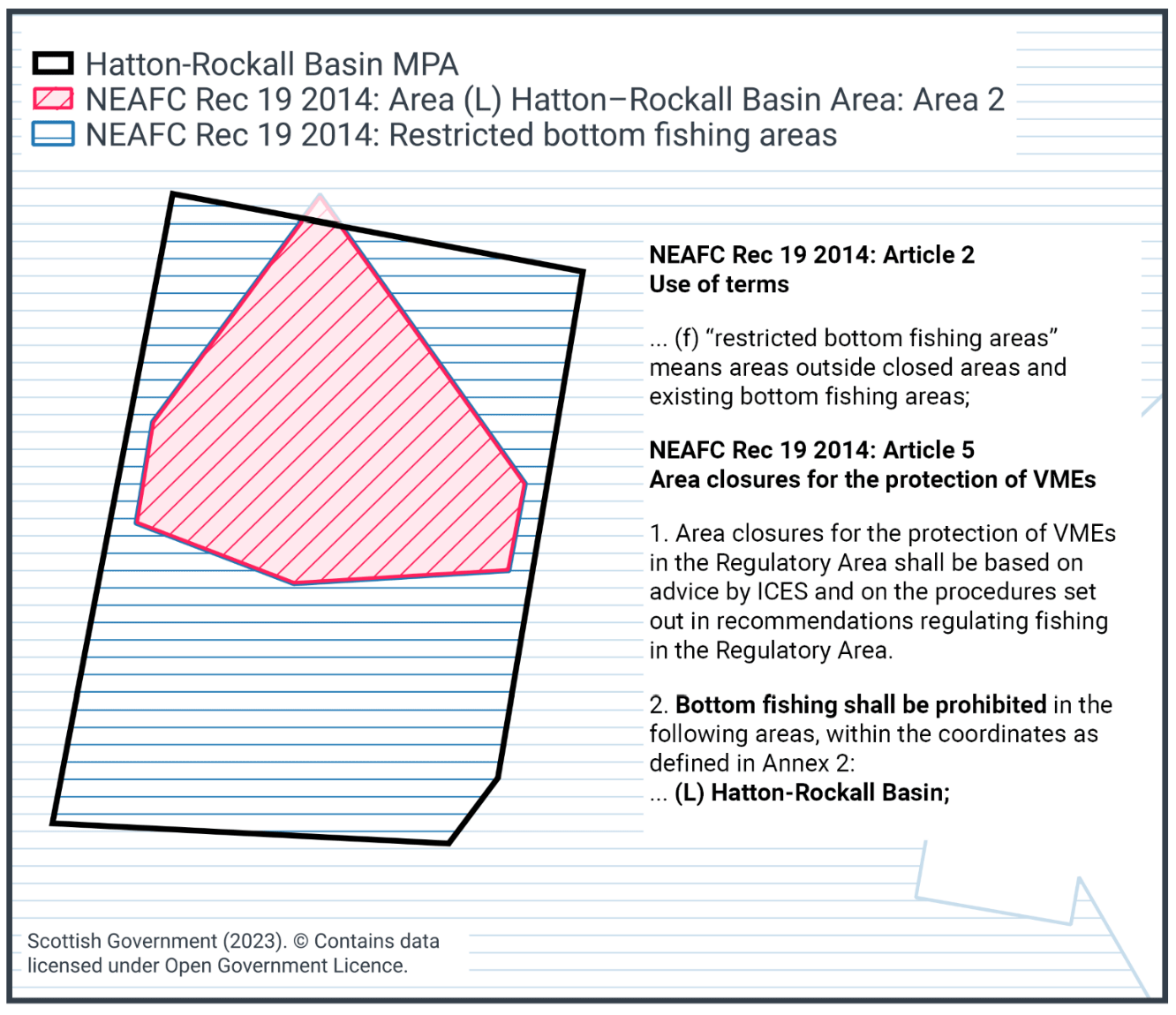Draft Fisheries Assessment – Hatton-Rockall Basin NCMPA: Fisheries management measures within Scottish Offshore Marine Protected Areas (MPAs)
These assessments look at the fishing activity occurring within each offshore MPA and SAC and assess the potential impacts of this activity on the protected features within each site. This assessment is for Hatton-Rockall Basin NCMPA.
2. Part A Assessment – Fisheries Screening
2.1 Fisheries screening overview
Part A of this assessment considers whether the fishing activity would be capable of affecting the protected features. This section looks at the pressures exerted by the fishing activity occurring in the site (within the assessment period) in relation to the sensitivities of the protected features. Activities potentially capable of affecting the protected feature were identified where there was both a medium-high risk of a pressure arising from the fishing activity and if any of the features were considered sensitive to that pressure. These pressure-features interactions were then taken forward to the fisheries assessment stage (Part B) to determine whether the fishing activity in question could or might hinder the achievement of the conservation objectives.
For each activity assessed in Part A, there were two possible outcomes for each identified pressure-feature interaction:
1. The pressure-feature interactions were not included for Part B:
a. If the features are not exposed to the pressure, and is not likely to be in the future; or
b. If the effect/impact of the pressure is non-existent or insignificant.
2. The pressure-feature interactions were included for assessment in Part B:
a. If the features are exposed to the pressure, or is it likely to be in the future; and
b. If the pressure is capable of affecting the feature; or
c. If it is not possible to determine whether the pressure is capable of affecting the feature.
Part B of the assessment considers the potential for activities to affect the feature by assessing the impact of fishing gears identified in Part A. This involves determining the potential level of interaction between the feature and the fishing activity, assessing the potential impact on the feature, and subsequently if fishing activities would or might hinder the achievement of the conservation objectives for the site.
Consideration of exposure to and the effect of a pressure on a protected feature of the NCMPA includes the consideration of exposure to and the effect of that pressure on any ecological or geomorphological process on which the conservation of the protected feature is wholly or in part dependant.
The JNCC Conservation Advice Package for Hatton Rockall Basin NCMPA has been used to inform this assessment. These are the most recent sources of conservation and management advice available. Where appropriate, this advice has been supplemented by information on pressures associated with fishing activity from JNCC Marine Pressures-Activities Database (PAD) v1.5 2022 and the Feature Activity Sensitivity Tool (FeAST).
2.2 Activities taking place within Hatton-Rockall Basin NCMPA
To screen out fishing activities that were not taking place within the site or likely to take place in the future, vessel monitoring system (VMS) data within Hatton-Rockall Basin NCMPA from 2015 – 2019 was analysed to identify the gear types being used in the site. The data showed that no forms of fishing activity currently occur within the Hatton-Rockall Basin MPA.
The absence of fishing activity can be accounted for by the current fisheries restrictions in place across the site. The relevant restrictions in place for this site come under the NEAFC Recommendation 19 : 2014 on area management measures for the protection of vulnerable marine ecosystems in the NEAFC Regulatory Area, as amended, requires that any new fishing activity would require an environmental assessment to show damage would not be caused to Vulnerable Marine Ecosystems (VMEs), which in this case constitutes one of the protected features of the site: deep-sea sponge aggregations.
An area in the north of Hatton-Rockall Basin NCMPA is also closed to bottom fisheries under NEAFC Recommendation 19 2014: Protection of VMEs in NEAFC Regulatory Areas, as Amended by Recommendation 09:2015 and Recommendation 10:2018 to protect VMEs, namely deep-sea sponge aggregations as shown in Figure 2.
Under The Common Fisheries Policy and Animals (Amendment etc.) (EU Exit) Regulations 2019 Statutory Instrument (S.I.) 2019, No. 1312 (amending S.I. 2019, No. 753) there is a prohibition on the use of bottom-set gillnets, entangling nets, and trammel nets at depths greater than 200 m for the protection of deep-water shark species. These protective measures are also applied in the North-East Atlantic Fisheries Commission (NEAFC) technical measures regulatory area (beyond European Union waters) through the same S.I. (Figure 2).

Graphic text below:
Map showing the two NEAFC restrictions applying to the MPA already. A roughly triangular area covers the north of the MPA, with the base at the midpoint of the MPA and tapering towards the north- this area is subject to NEAFC Rec 19 2014: Area (L) Hatton-Rockall Basin Area: Area 2. The remainder of the MPA is subject to NEAFC Rec 19 2014: Restricted Bottom Fishing Areas. The relevant legislation is cited in the image: Article 2 states "restricted bottom fishing areas" means areas outside closed areas and existing bottom fishing areas. Article 5 stats Area closures for the protection of VMEs in the regulatory areas shall be based on advice by ICES and on the procedures set out in recommendations regulating fishing in the Regulatory Areas. Bottom fishing shall be prohibited in the following areas, within the coordinates as defined in Annex 2 (which includes Hatton-Rockall Basin)
2.3 Part A Conclusion
Considering the information above and the absence of any fisheries activity within Hatton-Rockall Basin MPA, there are no current fishing activities which have the potential to affect the deep-sea sponge aggregations and offshore deep-sea mud within the Hatton Rockall Basin NCMPA. Therefore, no further assessment through Part B (fisheries assessment) and Part-C (in-combination) is required.
Contact
Email: marine_biodiversity@gov.scot
There is a problem
Thanks for your feedback